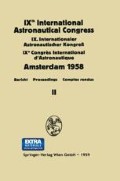Abstract
After a brief description of the R.A.E. satellite prediction service and a short section on Doppler measurements and their analysis, this paper goes on to describe the main features of radio interferometer and kinetheodolite observations of satellite orbits made by the staff of the Royal Aircraft Establishment. The development of a method of analysing the observations on a digital computer is given in broad outline, together with estimates of the accuracy with which a satellite’s position can be determined.
A table of orbital elements of the second Russian satellite is included and a comparison is made between the theoretical and observed values of the rate of rotation of the orbital plane. These differ by 0.7% and indicate the possibility of improving the accepted values for the coefficients in the formula for the earth’s gravitational potential field.
Zusammenfassung
Nach einer kurzen Beschreibung des R.A.E.-Satelliten-Vorhersagedienstes und einem gleichfalls kurzen Abschnitt über Dopplereffektmessungen und ihre Analyse werden die Grundlagen der Radiointerferometer- und Kinetheodoliten-Beobachtungen von Satellitenbahnen erörtert, die von dem Personal des Royal Aircraft Establishment ausgeführt wurden. Die Entwicklung einer Methode zur Analyse der Beobachtungen mittels einer elektronischen Rechenmaschine wird in breitem Umriß dargestellt, zusammen mit Schätzungen der Genauigkeit, mit der Satellitenpositionen bestimmt werden können.
Die Arbeit enthält eine Tabelle der Bahnelemente des zweiten russischen Satelliten Sputnik II. Es werden die theoretischen und die beobachteten Werte der Rotationsgeschwindigkeit der Bahnebene verglichen. Der Unterschied beträgt 0,7%, was auf die Möglichkeit hinweist, die angenommenen Werte der Koeffizienten in der Formel für das Gravitationspotentialfeld der Erde zu verbessern.
Résumé
Après une brève description du service de prédiction des orbites de satellites du Royal Aircraft Establishment et une courte section consacrée aux mesures Doppler et à leur analyse, l’article se poursuit par une description des principales caractéristiques des observations du R.A.E. avec radio-interféromètre et cinéthéodolite. Les grandes lignes du développement d’une méthode d’analyse des observations à l’aide d’une calculatrice digitale sont esquissées ainsi qu’une estimation de la précision qu’on peut attendre sur la prédiction de la position d’un satellite.
Une table des éléments de l’orbite du second satellite russe est fournie et la comparaison est faite entre les valeurs théoriques et observées pour la rotation du plan de l’orbite. L’écart de 0.7% indique la possibilité d’améliorer les valeurs admises pour les coefficients du géopotentiel.
Published in Astronaut. Acta 5, 26-39 (1959).
Access this chapter
Tax calculation will be finalised at checkout
Purchases are for personal use only
Preview
Unable to display preview. Download preview PDF.
References
Staff of the Royal Aircraft Establishment. Nature 180, 937 (1957).
K. L. Nielsen, Methods in Numerical Analysis. New York: Macmillan, 1956.
H. Jeffreys, The Earth, 3rd Ed. Cambridge: Univ. Press, 1952.
D. G. King-Hele and D. M. C. Gilmore, Unpublished M.O.S. report (a version is to appear shortly in Proc. Roy. Soc).
H. Jeffreys, Nature 162, 915 (1948).
Author information
Authors and Affiliations
Editor information
Rights and permissions
Copyright information
© 1959 Springer-Verlag Wien
About this chapter
Cite this chapter
Merson, R.H. (1959). Techniques of Analysing Terrestrial Radio and Optical Observations of Earth Satellites. In: Hecht, F. (eds) IXth International Astronautical Congress/IX. Internationaler Astronautischer Kongress/IXe Congrès International D’astronautique. Springer, Vienna. https://doi.org/10.1007/978-3-7091-4745-0_24
Download citation
DOI: https://doi.org/10.1007/978-3-7091-4745-0_24
Publisher Name: Springer, Vienna
Print ISBN: 978-3-7091-4595-1
Online ISBN: 978-3-7091-4745-0
eBook Packages: Springer Book Archive

